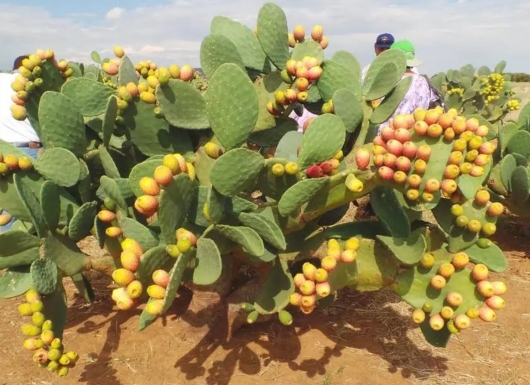Submitter: (ICARDA)
The spineless cactus emerges as a resilient crop, well-suited for drought-prone environments, particularly in hot and arid regions, offering a solution to combat desertification and generating livelihoods. This long-duration crop, with a lifespan exceeding 25 years, produces impressive biomass, ranging from 80 to 100 tonnes per hectare annually. Notably, every part of the cactus, including waste fruits, serves as valuable livestock feed, presenting a cost-effective feeding option. Additionally, cultivating spineless cacti presents an opportunity for income generation. It also serves as an excellent bioenergy crop, characterized by high biomass and significant biogas potential (60-65% methane). The residue obtained from the digestion process serves as a valuable fertilizer. Furthermore, the production of 3 kg of cactus yields a bio-leather sheet covering 3.38 square feet, which translates to the creation of either two pairs of shoes or three small bags.

Well-suited for drought-prone environments, particularly hot and arid regions. Existing and potential targets include India (Odisha, Madhya Pradesh, Rajasthan, Karnataka, and Uttar Pradesh), Pakistan, Ethiopia, Morocco, and Tunisia.
Demonstrated high biomass yields of 80-100 tonnes/ha/year and provides a reliable, cost-effective feed source during drought, reducing feed costs and livestock losses. Furthermore, the crop has demonstrated potential for biogas production and biofertilizer production, underscoring its role as a sustainable energy crop.
The spineless cactus is a climate-resilient crop that offers a solution to combat desertification and generates livelihoods. Its versatility as a 5F crop—providing food, fodder, fertilizer, fuel, and fashion- creates multiple income streams for farmers and supports sustainable livelihoods.
The crop thrives with little water, grows on poor soils, and can be integrated into existing farming systems, making it accessible and low-cost for smallholders. For adoption, it needs capacity building, dissemination support, and market linkages. Partnerships among research institutions, government agencies, and the private sector can accelerate uptake and ensure access to quality planting material and technical guidance.
Dr. Shiv Kumar Agrawal
Email: sk.agrawal@cgiar.org
M: +91 8375049950